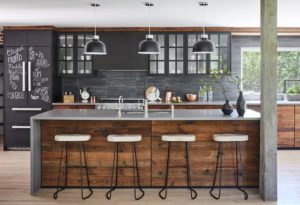Explore the three major interior design styles.

Achieving a cohesive home design is about more than just choosing attractive drapes, appealing light fixtures and eye-catching art. It’s an opportunity to make your home an extension of you—an outward expression of your taste. Colors, patterns, fixtures and other elements are all ingredients that influence the mood of anyone who enters your space. The home design palette is broad, so for guidance, it’s useful to identify where your preferences land among the overarching themes of contemporary, traditional and transitional home design. Each has its appeal, and as you understand more about them, you’ll begin to discern what elements excite you when considering, for example, a traditional versus transitional kitchen.
Remember, the contemporary, traditional and transitional design styles aren’t meant to limit you but offer you ideas and a path forward. When it comes to designing your home, the sky’s the limit, and you should follow your instincts to create a space that feels right to you.

Contemporary Design Style
The most modern of the three home design categories is contemporary. While time and trends can blur the lines between design styles, some hallmarks of contemporary design remain minimal decoration, ample and flexible open space, crisp lines and simple shapes. High contrast—from paint colors and finishes to textures and materials—is common as well. Form is highly prized in the aesthetics; contemporary kitchen faucets, for example, are sleek and sophisticated.
A home in this category makes a bold statement while still being comfortable to live in. If you could boil down contemporary design style to a simple phrase, “less is more” is probably the most accurate.

Traditional Design Style
Comfort and understated elegance define the traditional design style, along with warm, rich, inviting colors and very soft, tactile textures. Furniture, upholstery and other decor that relies on patterns and smooth shapes make interior spaces cozy and calming. Traditional spaces also embrace the bones of a house, with all of the inherent imperfections—such as exposed beams and stone walls. In the kitchen, the faucet might have a vintage look while containing the latest innovative technology.
One major plus of traditional design is that it’s timeless. Orderly yet unfussy, the decor will always be in style. If this type of design strikes a chord with you, some simple updates to start with are adding more natural textures and warm finishes throughout your home.
Mateo Single-Handle Pull-Down Kitchen Faucet with Touch2O and ShieldSpray technologies
Transitional Design Style
Befitting its name, transitional home design slots in somewhere between traditional design and contemporary design. You might also see this style referred to as “updated classic” or “classic with a contemporary twist.” Transitional design style is defined by blending elements from different eras to craft a uniquely personalized decor. Sophisticated yet simple, transitional design brings a light, tidy, comfortable atmosphere to the home.
To create this look, stick to clean, neutral colors on the walls to allow furniture, wood and fabric elements to become the focal point of the room. Classic stainless steel or black fixtures work well within this environment, providing a stylish feel, while bold-colored appliances can add a splash of personality to an otherwise neutral room. To borrow from more traditional design style, consider adding plush furniture and finishing in tones that tie with other elements of the room, such as the cabinets and fireplace mantel. In a transitional kitchen, natural wood cabinets typical of a traditional design may be coupled with a contemporary table and chairs with bold geometric forms. Transitional kitchen faucets hit the sweet spot between chic contemporary faucets and vintage-inspired traditional faucets.
Putting It All Together
As you plan your interior design projects, it’s worth reiterating that no matter whether you choose contemporary, traditional or transitional design themes for your home, there is considerable latitude among them. If you find parts of each appealing, that’s OK! Just remember to consider the purpose and function of each space in your home as you work out the overall design and pick pieces. Your home is your castle, so put some thought (and joy) into how you furnish and decorate it.
Thank you: 



